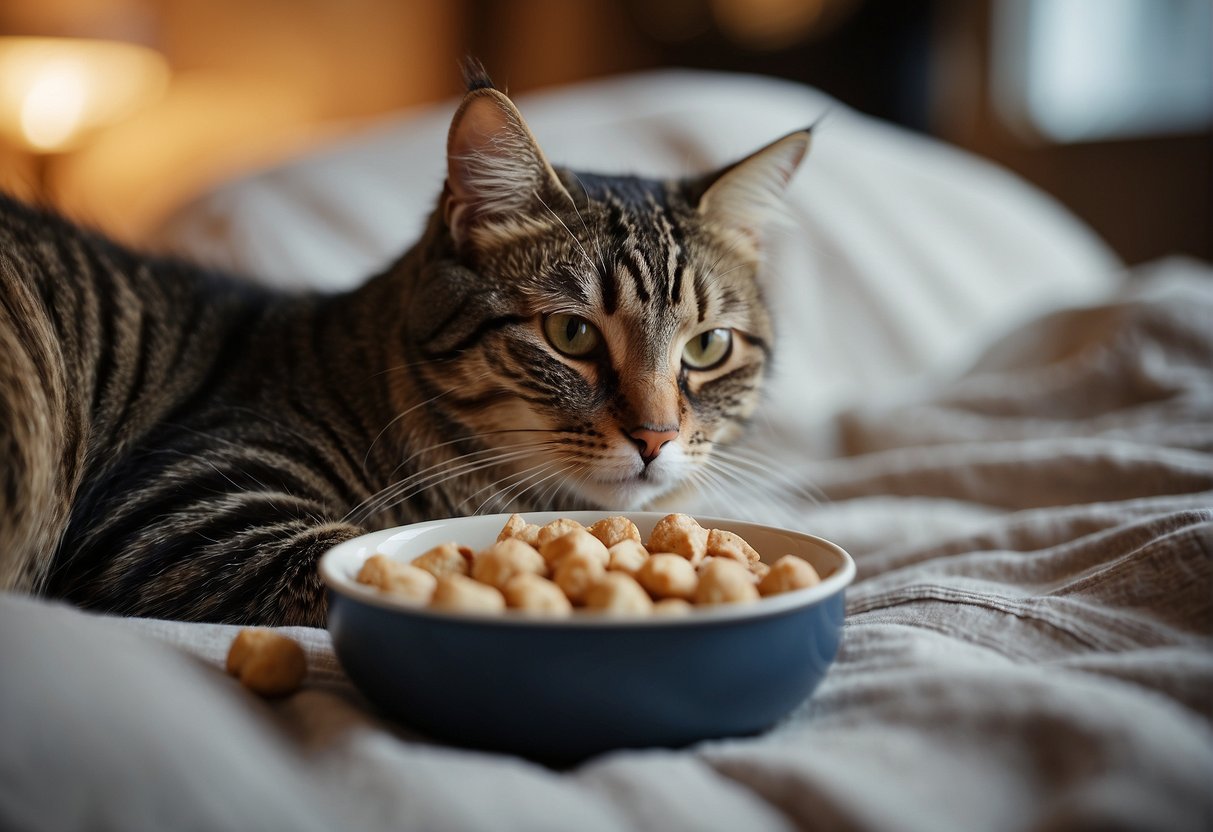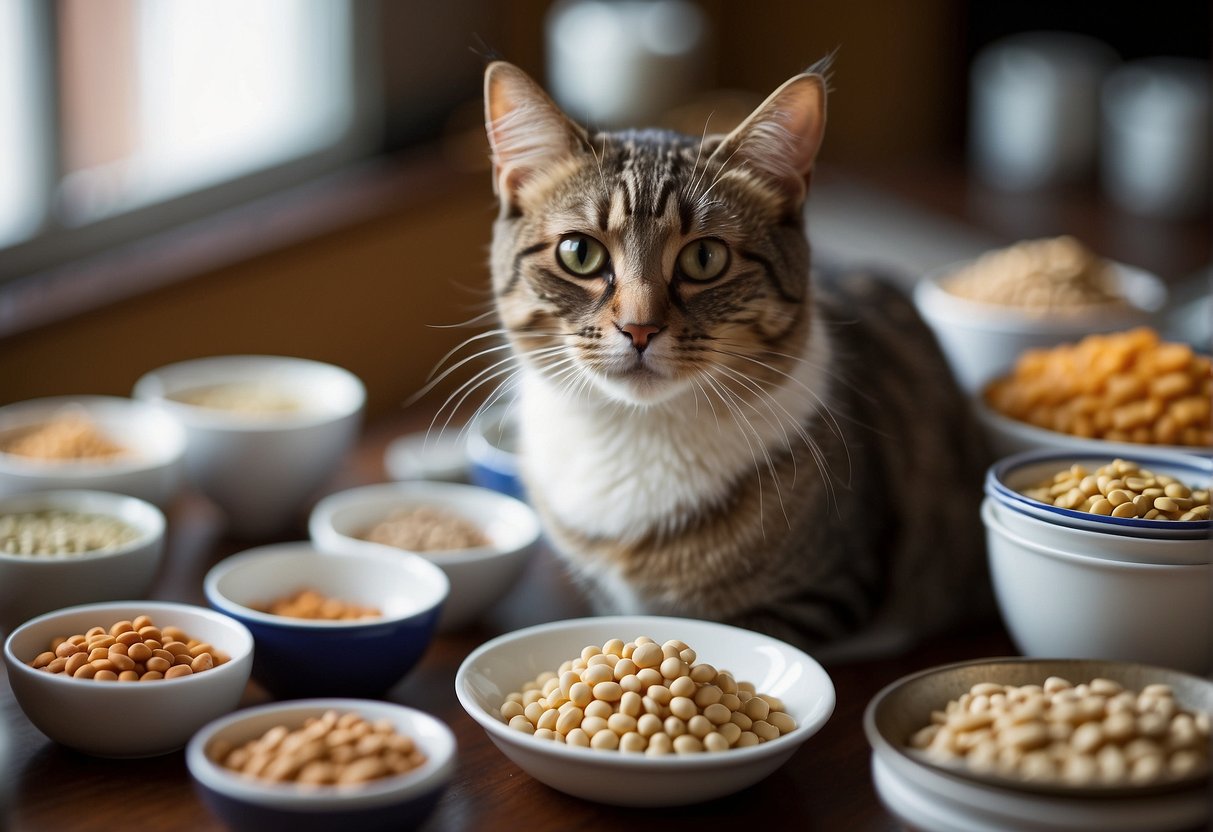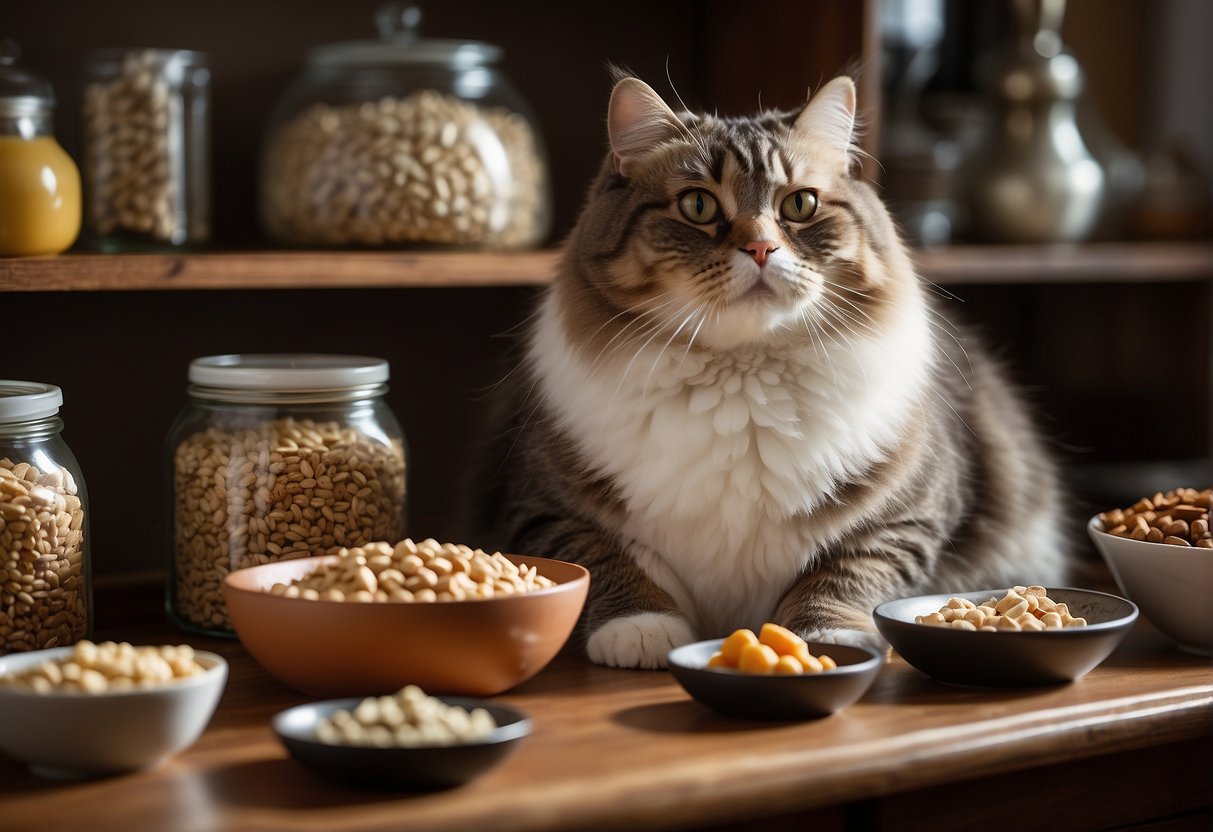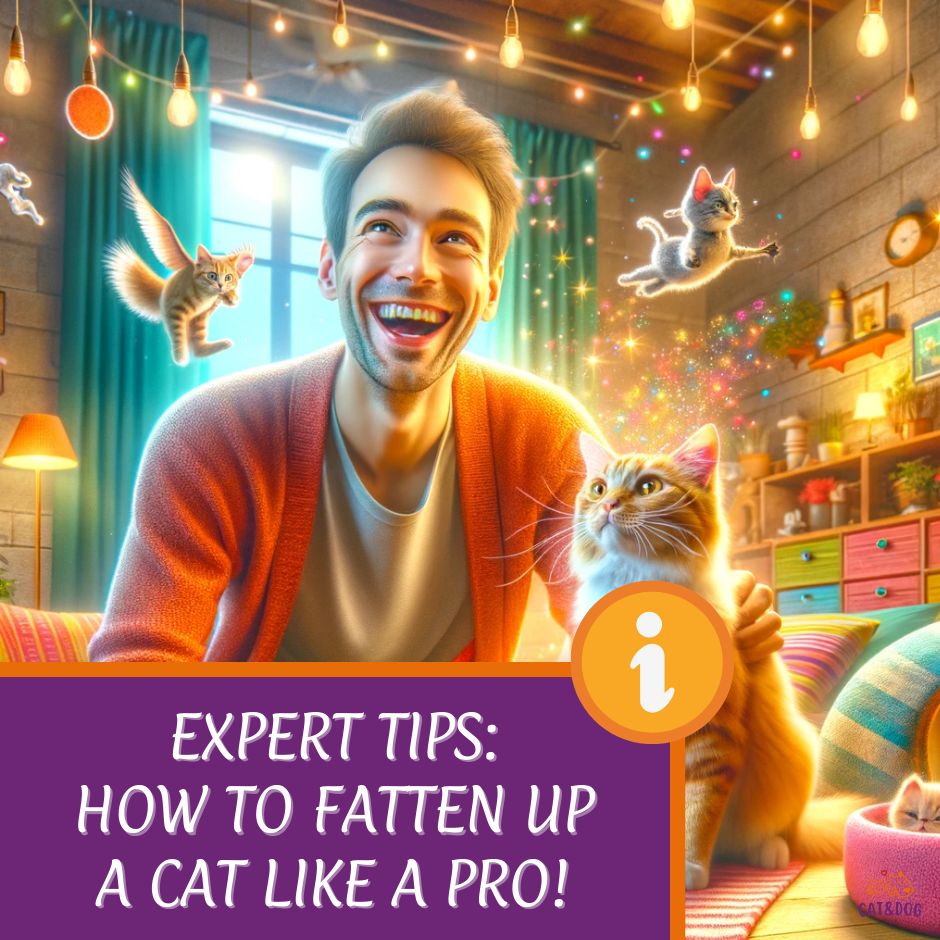Some healthy ways to fatten up a cat include feeding them a high-quality, calorie-dense cat food, offering frequent small meals throughout the day, adding wet food to their diet for added calories and hydration, and consulting with a veterinarian to ensure a safe and effective weight gain plan.
You’re not alone in noticing weight issues in cats, especially when it comes to older felines.
In fact, underweight cats, especially older ones, are a fairly common concern among pet parents. (1)
Striking the right balance between undernutrition and overfeeding can be a bit of a tightrope walk. Think Goldilocks, but for cats – you want everything just right to avoid anorexia or malnourishment.
Once your older feline hits their ideal weight, ration their meals according to their current needs. Even a month of overfeeding can make cats obesity.
Both feline obesity and anorexia are two sides of the same coin—they impact your pet’s quality of life.
For more information, check out our guides on how to fatten up a cat safely using top tricks and techniques.

As much as we want our fur babies to be healthy and chubby, it’s crucial to approach monitoring and managing your cat’s weight gain in a safe and responsible manner.
Veterinarians and animal nutritionists emphasize the importance of healthy weight gain. This ensures that your cat doesn’t just gain fat, but also maintains muscle mass and overall health. (2)
If you think your kitty needs to gain weight, you should first bring them to the veterinarian so that underlying medical conditions, if any, can be ruled out.
After all, we all want our whiskered companions to thrive, not just survive! In general, diets designed for weight gain are calorie dense, meaning that a smaller volume of food is required to provide the necessary calories for weight gain.
Your veterinarian may recommend a specific diet to help your cat gain weight. Calorie dense foods tend to be high in fat because fat contains more calories per gram versus protein or carbohydrate,” Lenox explains.
When considering diets to help your cat gain weight, it’s important to include cat food that is rich in fiber, as it aids in digestion and promotes overall gut health.
A malnourished kitty should eat high-protein wet food with real meat and fish every day to gain a healthy weight.
Avoid products with high fat or carb content (excess carbs are broken down into excess fat and stored in cells) as they add to unhealthy fat mass rather than bulking up muscles and bones.
The specific nutrient balance your cat needs to gain weight or recover after sickness may not be provided by extra portions of food alone.
For example, they may benefit instead from a specific diet with added prebiotics to help rebalance their gastric microflora and strengthen their digestive health.
Your cat’s weight-gain food should have a high energy density. Biscuits provide the necessary calories, while gravy and jelly add the necessary proteins, amino acids, and fatty acids to the mix.
Key Takeaways
- Identifying underweight cats is key to understanding and commencing their weight gain journey.
- Veterinary guidance is essential for safe and effective weight management.
- Nutritional strategies and controlled feeding practices are central to healthy weight gain in cats.
Understanding Underweight Cats

It’s not just a fur coat that’s been through the spin cycle one too many times. Underweight cats can exhibit several telltale signs that should have you raising an eyebrow (or a whisker, if you could).
Let’s pounce into the details of understanding underweight cats and the potential causes for their weight loss.
One of the main causes for a skinny cat is not eating enough, which can be due to stress, dental disease, anorexia, nausea, or parasites.
Identifying if Your Cat is Underweight
Keep your eyes peeled for:
- Protruding bones: If you feel your cat’s spine or hips quite easily, it’s time for a check-up.
- Lack of energy: A cat that’s more listless than a sunbathing lizard could be under-fueled.
- Visible ribcage: It’s not a cat’s version of a six-pack. A visible ribcage often indicates insufficient weight.
A Body Condition Score chart can be your best pal when deciphering the scale of the situation.
Common Causes of Low Weight in Cats
Your cat’s weight is a balancing act, and when that scale tips low, there’s usually a sneaky culprit. Here’s the lineup:
- Dental issues: Painful chompers can turn dinner time into a no-go zone.
- Digestive problems: Upset tummy equals minimal munching.
- Stress: Yes, cats can be worrywarts too, affecting their appetite.
Veterinarians often share anecdotes about cats like Mittens, whose disdain for her new doggy roommate led to a serious snubbing of her kibble.
It took some clever feeding strategies and stress reduction to get her back on track.
Remember, when in doubt, a trip to the vet is like hitting the ‘purr’ button for your cat’s health.
Stay alert, stay informed, and keep those kitties robust and well-rounded—literally!
The Role of Veterinary Care in Cat Weight Management
Yes, your vet isn’t just there to give vaccines, but they are pivotal in managing your kitty’s waistline. It’s like having a personal nutritionist for your furball!
Importance of Regular Veterinary Check-Ups
Why regular vet visits? Well, for starters, about 60% of cats are either overweight or obese. Shocking, right?
Your vet’s keen eye can spot the not-so-obvious signs of a tubby tabby.
They help diagnose any sneaky health issues that might be playing a role in your cat’s cuddly physique, such as Inflammatory Bowel Disease (IBS). (3)
Think thyroid problems or diabetes – not your everyday suspects. These regular check-ups are important for maintaining your cat’s overall health and well-being. (4)
- Ensure early detection of weight-related health conditions
- Provide a tailored diet plan for your cat’s needs
- Monitor any changes in health status
Monitoring Weight Gain Progress
Vets are like detectives; they use tools like weight charts to monitor Mr. Whiskers’ gains:
- Regular weigh-ins help chart progress
- Monthly check-ups for a hands-on evaluation
- Weight charts keep everyone on track
This detective work is crucial. Too fast of a weight gain may indicate overfeeding, while too slow could suggest an underlying issue.
It’s all about balance, and your vet’s job is to find that sweet spot.
Oh, and those regular check-ups? They’re your roadmap to success. Think of them as your pit stops in the weight gain race—ensuring everything is running smoothly under the hood.
Remember, each cat is an individual; what works for Garfield might not work for Felix. So, trusting your vet to guide this journey can make all the difference in your cat’s health and happiness!
Nutritional Strategies for Weight Gain
When it comes to your fluff ball gaining a bit of weight, the right food makes all the difference. Have you considered a high-calorie, nutrient-rich menu for your cat?
While focusing on increasing your cat’s weight, it’s essential to be mindful of obesity risks in cats, ensuring that the weight gain is healthy and does not contribute to overweight issues or related health problems.
It’s like planning a feast fit for a feline king or queen!
Choosing the Right Food for Weight Gain:
- High-calorie Diet:
Your cat’s diet should be like their very own buffet of high-calorie goodness. Look for foods labeled as high-energy or kitten formula. These are usually power-packed with calories. - Nutrient-dense Foods:
Your kitty deserves the best. That means food rich in proteins and fats, essential for healthy weight gain.
Tailoring Diet to Individual Cat Needs:
- Kittens and Young Cats:
They’re little energy balls, aren’t they? They’ll do well with kitten formula, which is like rocket fuel for growth and play. - Senior Cats:
Older whiskers on the block might need food that’s easy to chew and still nutritious. Consider softer, calorie-dense foods. - Less Active Cats:
If your fur friend prefers the couch to a game of chase, they’ll need fewer calories but still sufficient nutrition. Quality over quantity is their mantra!
Including seafood in your cat’s diet, especially options rich in omega-3 fatty acids, can provide high-quality protein and essential nutrients that support healthy weight gain and overall well-being.
Remember, every cat is unique, so keep an eye on their weight and adjust their diet as needed.
Your vet is like your lifeline here – a great source of customized advice for your cat’s specific needs!
Not sure how much to feed them? A general rule paw… I mean thumb, is to check the feeding guidelines on the cat food label. Easy right?
Let’s keep things simple and clear – just like your cat’s sparkling eyes when they spot dinner. Keep their food bowl an exciting place, and you’ll see them blossom in no time!
Feeding Practices for Healthy Weight Gain
It might be time to reassess their eating habits and figure out a plan to get them back to a purr-fect weight!
Developing Effective Feeding Strategies:
First off, who’s up for a snack? I bet your cat is! Instead of two big meals, how about offering smaller, more frequent meals throughout the day? Here’s what a sample schedule could look like:
- Morning: Begin with a hearty breakfast to kickstart their metabolism.
- Mid-morning: A small snack keeps those energy levels steady.
- Lunch: It’s noon, and a well-portioned meal is served.
- Afternoon: Snack time again! This helps avoid an afternoon slump.
- Dinner: As dusk falls, serve dinner—all the nutrients needed to tide them over until morning.
- Before Bed: A final small snack can help through the night.
You might find your cat’s appetite reflecting the more regular schedule. And hey, while we’re at it, let’s turn mealtime into a highlight of their day.
Creating a Positive Feeding Environment:
Did you know cats can be quite the foodie, given the right ambiance? Imagine if you had to eat in a noisy, crowded place—yikes! Similarly, a relaxing, quiet spot for your cat can transform mealtime.
A friend of mine set up a cozy corner away from the household hustle, and guess what? Her cat, previously a finicky eater, turned into a little food enthusiast.
Anxiety can cause a loss of appetite, so it’s important to create a stress-free environment for your cat during mealtime to ensure they maintain a healthy weight and mental well-being.
When it comes to food, quality and taste are kings. If your senior feline companion turns up their nose at their kibble, try introducing a variety of flavors and textures, like new food options such as cat’s food.
Some cats are fans of wet food, while others prefer their bites crunchy. It’s all about finding that chef’s kiss for your little furball.
An easy way to know if your cat has any particular preference is by offering different kinds of food all at once and seeing if they have a specific liking, which can be determined through trial and error.
This simple method allows you to quickly identify the food your cat likes and accepts the best.
By incorporating Untamed’s vet-formulated recipes into your cat’s meals, you can ensure that they receive all the essential nutrients for healthy weight gain.
Untamed helps your senior feline companion maintain or regain their muscle mass, making it an excellent choice for picky cats who refuse to eat because Untamed dishes taste great and sweep even the fussiest felines off their paws.
While it’s normal for older cats to lose a few pounds, our nutrient-dense meals keep them vigorous and help them retain a decent body mass in their golden years.
Our products contain two times more protein than the industry standard and are free of all known allergens.
Your cat will feast on the finest cuts of chicken and duck breast, salmon, sardine, and mackerel fillet, chicken liver, and shrimp.
Remember to maintain a clean feeding area. It’s simple: would you eat off a dirty plate? Keep your cat’s dishes spotless, and they’ll thank you for it.
And there you have it! Patience is key, and soon enough, your cat’s energy levels and weight should be looking up. Happy feeding!
Practical Tips and Examples for Cat Owners
It’s important to do this the healthy way, so let’s talk turkey—or should I say, let’s talk tuna!
Easy-to-Implement Feeding Schedules
- Kittens: They’re growing machines, so feed them four times a day with high-protein kitten food.
- Adult Cats: Twice a day with a mix of wet and dry food can keep things balanced.
- Senior Cats: They might need a touch more encouragement, so consider more frequent, smaller meals throughout the day to entice their appetite.
Ever heard of meal planning for cats? It’s not as tricky as you might think. Here are some examples for a well-rounded daily diet:
Examples of Balanced Daily Meal Plans
- Breakfast: Some delicious wet food (high in protein) to kickstart their day.
- Lunch: A small portion of dry food for that satisfying crunch.
- Dinner: More wet food—remember, meat’s the treat that can’t be beat!
- Before Bed Treat: A little bit of cat-safe cooked protein, like chicken or fish, to top it all off.
Stick to vet-approved foods, and remember, every cat is unique. Consult with your vet first, especially if your cat has health concerns.
Have you measured your cat’s food lately? Make sure you’re giving the proper portions. Your vet can help you chart out the exact amounts based on your cat’s specific needs.
Remember, the average adult cat weighs between 8 and 12 pounds, so use that as a loose guideline.
Of course, a Maine Coon will tower over a Siamese—size definitely matters here! (5)
And that’s all, folks! With these simple tips, you’re on the road to having a happily plumped-up kitty in no time!
Monitoring and Adjusting as Needed

It’s similar to us humans setting a New Year’s resolution to get fit—achievable goals are key. Imagine, for instance, your cat is the furball version of Cinderella trying to get fit for the ball—moderation is everything.
Setting Realistic Weight Gain Goals First things first, let’s talk numbers. Setting a realistic weight gain goal for your cat should follow a vet-approved plan.
Picture this: Fluffy was a bit under the weather and lost a couple of ounces. Instead of aiming for instant chubbiness, aim for gradual changes, just like our hypothetical Cinderella prepping over time for the ball.
- Week 1-4: Small increases, monitored weekly
- Week 5-8: Assess progress, adjust as necessary
Regular Check-Ups and Adjustments Remember, your vet is your partner in crime (the good kind, promise!), guiding you and your cat through the weight gain journey.
It’s like having a personal trainer for Fluffy. Vets often say, “Weight gain is a marathon, not a sprint.”
Thus, regular check-ups are crucial to ensure there aren’t any underlying health issues, tweaking the diet as your cat evolves into their healthier self.
You wouldn’t want Cinderella’s dress to be ill-fitting at the grand event, right?
Additionally, if your kitty shows no improvement in their weight despite following a rigorous weight gain program for over a month, you must take them for a full veterinary evaluation.
Unexplained weight loss is often associated with diabetes, hyperthyroidism, and intestinal cancer, which can be detected through bloodwork.
Some of these conditions can be managed with prescription meds and a suitable diet.
If your cat doesn’t gain weight, it’s important to address the possibility of weight loss and seek veterinary advice to rule out any underlying health issues, such as hepatic lipidosis, sometimes called “fatty liver.”
Diarrhea can also be a sign of an underlying health issue, so it’s important to monitor your cat’s digestive health as well.
Example Vet Quote:
“I once had a patient, Sir Purr-a-lot, who needed to gain weight. We made small adjustments to his diet every few weeks, and within months, he became a healthy, happy cat living his best nine lives.”
By breaking down the process, monitoring your cat’s weight, and adjusting their diet with your vet’s guidance, you’ll have a content, well-fed cat—imagine a feline food connoisseur, if you will.
Just remember, patience is a virtue, especially in the quest for kitty chubbiness!
Quick Recap
Wondering if you’ve missed any morsels of wisdom on plumping up your purring pal? Here’s a bite-sized reminder just for you!
Health Check:
First thing’s first, chat with your vet to ensure your feline friend is fighting fit and free from sneaky health issues like hyperthyroidism or dental discomfort that might be behind their lean look.
Optimal Diet:
Ready to revamp Rover’s routine? Consider a diet designed for weight gain, or switch up their current chow to something even yummier and more appealing.
Remember, the average housecat tips the scales at about 10 pounds.
- Snack Smart:
Cat treats and supplements can be your partner-in-crime for a chubbier cat, but keep it healthy. - Feeling the Ribs:
Just how snuggly should your kitty be? If their ribs feel like your knuckles, that’s a skinny signal; back of your hand is just purr-fect.
Consistent Meals:
Set a regular feeding schedule and keep those portions generous, but appropriate – we’re not running a cat buffet here!
Hydration is Key:
Keep the water bowl full! A well-hydrated cat is a happy cat.
Does this seem like a lot to keep track of? Don’t worry, your vet is just a call away to help you navigate the numbers and nibbles and set the right course for a healthier, heftier kitty.
Keep it light-hearted, but keep it serious where it matters. Your cat’s health is the main course, after all!
Frequently Asked Questions

If you’ve noticed your feline friend looking a bit on the lean side, you may have some questions on how to safely help them gain weight.
From spotting signs of an underweight cat to choosing the right high-calorie foods, let’s jump right into your burning questions.
What are the signs my cat is underweight?
You’ll notice that an underweight cat might have visible ribs, backbones, and hip bones.
They may also lack muscle mass and have a noticeable loss of fat padding.
How much weight should an underweight cat gain each week?
Steering clear of rapid weight gain is crucial.
Your vet might recommend aiming for a safe and steady increase of about 1% of their body weight per week.
Can certain cat breeds be naturally thinner?
Yep! Breeds like the Siamese or Oriental can be svelte by nature, sporting a leaner physique as part of their genetic makeup.
What’s the fastest way to help a kitten gain weight responsibly?
Kittens are growing bundles of energy!
A nutrient-rich diet specifically formulated for kittens can help them gain weight at a healthy pace.
What are the best high-calorie foods for cats?
High-calorie cat foods often pack more protein and fats.
Look for quality foods labeled as ‘high energy’ or consult your vet for recommendations based on your cat’s needs.
How can I encourage my picky cat to eat more?
Tempt your picky eater with a variety of textures and flavors, and consider warming their food slightly to enhance the aroma.
Is it safe to give my cat supplements for weight gain?
Before adding supplements to your cat’s diet, it’s a must to have a vet’s green light to ensure they complement your cat’s unique health profile.
- Where to find the most trustworthy real money casinos - August 7, 2025
- Online Casinos That Approve PayPal: The Ultimate Overview - August 7, 2025


